Woodpeckers
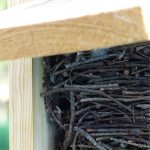
The wrens use just their beak and claws to layer sticks and then feathers from other birds to make a cozy safe nest to raise young.
Just ten days ago the wren parents fledged the babies from the box on our deck. After we knew they were safely gone, Rich unbolted and cleaned out the next. What an amazing feat of engineering! With just a beak and claws, the wrens fashioned a comfy, warm home to sit on eggs and raise young. All was quiet for the rest of the week. The birds had all dispersed.
The past few days we have noticed activity in the High Bush Cranberry, on the deck, around the pond and at the feeders. Today, definite mating activity as up to five wrens competed for attention, displayed mating moves and two began rebuilding the box on the deck. In and out flew the wren gathering small sticks by the pond and placing them in the box. So, it looks like a pair plans to start one more brood.
Later in the year, the Carolina Wren will grace our yard. Larger and more distinctive, it seems to fare well in Iowa even in cold weather.
Late June into mid-August is exciting, dangerous and nostalgic for all creatures fledging – including people!
Birds and wild creatures have mated, nested, and are raising young. For some this takes weeks, months or years (kids). This spring has been fun watching the rabbits and variety of birds growing up and fledging. At the same time, Marion has been reading the Jean Craighead George series: My Side of the Mountain, The Far Side of the Mountain, and Frightful’s Mountain. About experiencing the power of observation as nature unfolds.
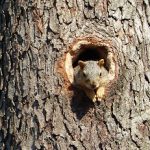
It’s a long way down, Mom.
A squirrel family nested in a hole in an oak within view of the back deck. One spring day we spotted a young squirrel just looking out. Soon after, we saw young in all the fruit trees hanging upside down. We think that their dexterity must be developed in part by their having been gestated in the moms leaping from branch to branch and raised in wind whipped trees.
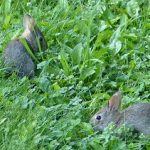
Bunnies are on their own as soon as the mother weens them.
Recently, Rich spied a young rabbit family nest under a maple tree. This spring most ground reared animals like bunnies, turkeys and pheasants were safe from storms. So, the rabbits are prolific! They are hilarious to watch in different stages of growth from naive hand sized bunnies to teen-sized rabbits to adults. They often hold convention on our front and back lawns. They seem alert and always near tall grass because the owl population has grown – we hear them hooting at dusk.
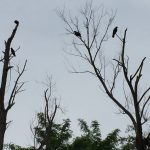
Crow family fledging
Crows suddenly seem to appear yet they have been around all the time. In tall trees a family hangs out watching for food. On the ground you can tell the adults and young by watching who feeds whom. At some point the adults say, “You are on your own!” Off they fly and the young have to survive.
Wrens and Cardinals are always a treat to watch. The one nest off our back deck gave us great viewing as the pair bonded, set up home, fed each other as one sat on eggs, and the babes grew from a chittering brood to fully fledged and out of the nest in a matter of weeks. Now the box and deck are strangely and sadly quiet. But, the fledglings frequent the shrubs nearby, still entertaining us.
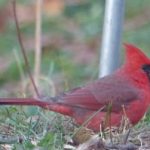
Cardinal on Ground
Cardinals are perhaps my favorite only because I watched a family grow and fledge the same time our daughter graduated and left for college.
All the animals are amazing to watch. They are smart, adaptable and instructive. We learn a lot watching them. By next spring their numbers will be decreased as many die from predation, accidents, weather and interactions with humans. Meanwhile, keep your eyes and ears alert for these incredible creatures with whom we share this ecosystem.
A joy of inviting beautiful wildlife to a yard is the periodic chance to see something new. That happened recently at Winding Pathways. We were astonished to spot a Black Poll warbler in our oaks. It was the first of this species we’d ever seen anywhere. Another amazing sight happened on a clear March morning when sounds from above brought us outside. We were thrilled to watch a huge flight of snow geese winging north way over our house.
We’re not overly serious birders, but keep a running tally of species spotted each year. Lists are fun, especially for people with a competitive bent. We identify birds by either sight or sound, and use these clues in our count of yard visitors. We also include some species that fly over but don’t land. Winding Pathways is two acres. And, we’re fortunate. Just past our property line is 110 acre Faulke’s Heritage Woods. Its large oaks and elms attract forest birds that might not normally visit our yard.
Here’s our running tally this year as of mid-May:
Wild Turkey
Seven woodpecker species (Hairy, downy, red bellied, red headed, sapsucker, pileated, and flicker)
House Finch
English Sparrow
Junco
European Starling
Native sparrows (white crowned, white throated, song, fox, chipping)
Indigo bunting
Warblers (black polled, yellow rump, yellow, palm, and redstart)
Oriole, orchard and northern (Baltimore)
Cardinal
Tufted Titmouse
Black Capped Chickadee
Hummingbird
Wren (house and Carolina)
Goose (snow and Canada flying over)
Ducks (mallard and wood)
Owl (barred and great horned)
Hawk (Coopers, sharp shinned, red tailed)
Turkey vulture
Chimney Swift
Nighthawk
Brown Creeper
Cuckoo
Goldfinch
Robin
Crow
Killdeer
Whip-poor-will
Mourning Dove
Bald eagles
As we continue to add a diversity of shrubs, trees, grasses, and wildflowers we’re creating habitats that should lure new species to our yard. We’ll keep adding species as the year goes on.
We use several references to help identify birds. Here are our favorites:
Printed books. Real bird books:
The Peterson Field Guide to Birds of North America. This 2008 book is fairly large and heavy, we keep it in the house to aid in identification.
The Golden Guide to Field Identification. Birds of North America. This classic bird book has been around for years. It’s small and easy to carry and is the book that stays in the car and gets carried when we’re walking a trail seeking birds.
The Sibley Guide to Bird Life and Behavior. This details the life history of birds. It’s a heavy large reference book that provides information on a bird once we’ve used other sources to make an identification. A companion Sibley book helps with identification.
Electronic Identification Aids
Outstanding information sources come from the Cornell University Laboratory of Ornithology, both on their website and on their smart phone app called Merlin. We use Merlin regularly when in the field. Although it lacks some species our iPhone is easy to carry and the organization of the app makes it easy to identify a new species. The app includes several still photos of each bird, range maps, and the call and song of the bird. It’s Free!
When at home we often access the Lab’s Website. It includes more extensive information on more species than the iPhone app and has video clips. It is outstanding, and access is also free. We like it so much we joined the Lab and appreciate receiving its gorgeous and informative magazine called LIVING BIRD. The Lab’s general web address.
At the end of April house wrens returned to Iowa right on schedule. Every year they seem to appear like magic. Where they were absent just a day or two before the yard suddenly seems to be filled with wren antics and their effervescent voice.
House wrens winter throughout South America and summer across most of North America. Many make their home year round in Mexico.
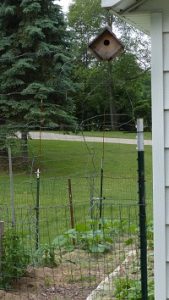
Wrens feast on insects that pillage gardens.
Wrens love suburbia with its diversity of buildings, shrubs, shade trees, and gardens. Soon after arriving in Iowa, a wren pair begins housekeeping. Of all birds house wrens are probably the easiest to lure into a birdhouse. They are not shy. The nest box can be positioned where viewing the emerging family is easy. Wrens also are not fussy. If they can’t find a tree cavity or bird house they’ll move into an old shoe or tin can.
Wrens are tiny birds with enormous appetites. They dine on adult insects, caterpillars, spiders, and many other invertebrates that most people consider pests. A pair nesting near a garden will forage amid vegetables and flowers seeking crop damaging insects.
Perhaps the best wren attributes are their utter cheerfulness and energy. Few wild animals are more fun to watch and listen to. Anyone unfamiliar with the distinctive call of this delightful bird can go to the Cornell Laboratory of Ornithology All About Birds. Type in” house wren” and learn more about this amazing summer Iowan and hear its call.
We recently noticed a tiny water drip above our dining room table. It looked like we had a roof leak. Instead of dragging the heavy ladder out to check the roof we grabbed a pair of binoculars that we always keep handy. From the yard the binoculars gave us a close up view of our shingles without the hassle and danger of being on the roof. They looked OK.
We next checked upstairs pipes. Sure enough we found a slight leak that was easy to fix. We were happy we never had to go up on the roof.
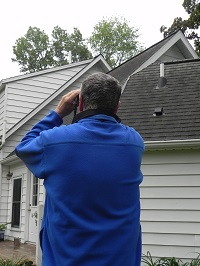
From the yard the binoculars give us a close up view of our shingles without the hassle and danger of being on the roof.
Although many people consider binoculars only useful for wildlife or sports viewing, we find them handy for household inspections. We usually have a pair handy and mostly use them for viewing nature and occasionally when we go to the theater or a ball game.
Binoculars have undergone an amazing boost in quality since grandma bought a pair years ago. Today they are available in all sorts of shapes, sizes and magnifications. Relative to inflation, they are less expensive than those of yesteryear. Unfortunately, with so many types on the market buying the perfect pair can seem complicated. Here’s how we choose ours:
First, know what the numbers mean. Binoculars have two numbers, such as 8X42. The first number indicates its magnification. For example objects will look 8 times closer with an 8 power scope.The second number is the objective lens. It is the diameter of the lens farthest from the eyes.The bigger the number the larger the glass will be and the more light the lens will admit. A high number, such as 8X50 will allow the best viewing in dim light and are excellent for astronomy. The downside is their size. They are large. Ten or twelve power binoculars will bring images closer than 8 power but they have two downsides. The higher the power the harder it is to hold them steady.The image will jiggle a bit. Also, the field of view gets smaller as power increases.Trying to locate a tiny bird in a distant tree grows increasingly difficult as power expands. Some binoculars have an image stabilizer which helps. Read the specifications to learn many details of any pair.
Second, decide what you are going to use them for. Most people are best served with a general purpose pair. Usually this means 8X42. These are perfect for use around the house or carrying in the car. For travel and concerts, tiny 8X20 compact binoculars are about the size of a cell phone and weigh next to nothing. They are a bit less comfortable to use than full size ones but will bring a colorful bird, scenic view or performer up close. Some binoculars are water proof, a plus for anyone using them from a boat or out in the rain. Rich prefers binoculars that focus closely since he often views butterflies or bees on flowers just past his toes. Not all binoculars focus closely.
Third, decide how much money you will spend. We avoid bargain basement binoculars that sell for around $29. They are hard to use and don’t give a good view. They also break easily. On the other extreme are expensive, usually European, binoculars. We’ve never had the cash to buy one of these. Happily, hundreds of excellent binoculars are on the market. They start at around $100 or $125 a pair and range up to around $500. The higher priced ones usually give a brighter image and are clear even toward the edge of the viewing area.
The Binoculars We Use At Winding Pathways
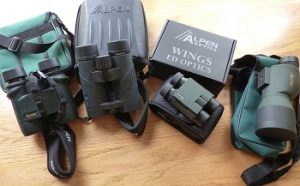
Alpen optics provide quality with great value.
We have several pair of binoculars. Here are the ones we most often use:
Marion prefers 10X32 Alpen Apex around the house and while car touring. These have excellent optics and are relatively small sized. They fit her smallish hands well.
Rich prefers 8X42 Alpen Wings ED for yard and car use. He keeps a pair of Alpen Apex 8X42 in his pickup truck all the time.These are somewhat larger than the pair Marion prefers and fit his large hands well.
Both Rich and Marion carry a pair of Alpen Wings ED in 8X20 when traveling or heading for the ball field or theater. Tiny with excellent optics they easily slip into a purse or jacket pocket.
While we have enjoyed using many other brands of binoculars that provide excellent viewing at reasonable cost, we particularly like Alpen.